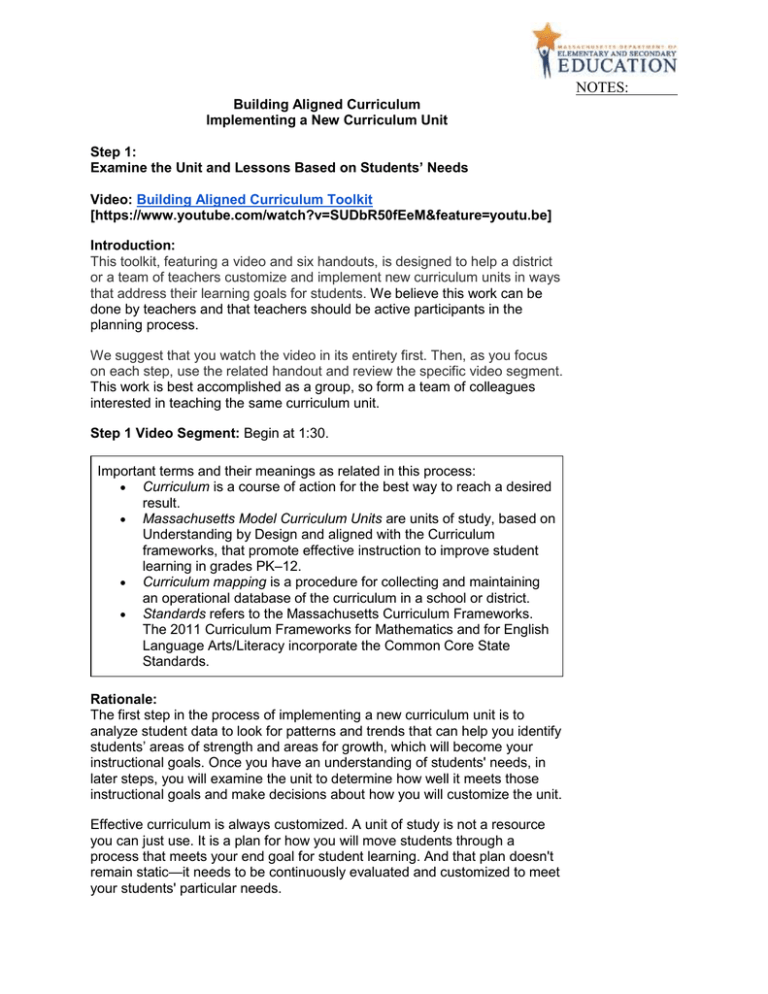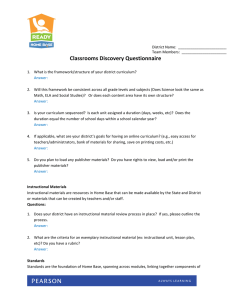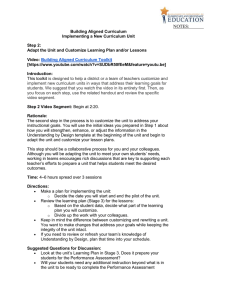BAC Toolkit Step1
advertisement

NOTES: Building Aligned Curriculum Implementing a New Curriculum Unit Step 1: Examine the Unit and Lessons Based on Students’ Needs Video: Building Aligned Curriculum Toolkit [https://www.youtube.com/watch?v=SUDbR50fEeM&feature=youtu.be] Introduction: This toolkit, featuring a video and six handouts, is designed to help a district or a team of teachers customize and implement new curriculum units in ways that address their learning goals for students. We believe this work can be done by teachers and that teachers should be active participants in the planning process. We suggest that you watch the video in its entirety first. Then, as you focus on each step, use the related handout and review the specific video segment. This work is best accomplished as a group, so form a team of colleagues interested in teaching the same curriculum unit. Step 1 Video Segment: Begin at 1:30. Important terms and their meanings as related in this process: Curriculum is a course of action for the best way to reach a desired result. Massachusetts Model Curriculum Units are units of study, based on Understanding by Design and aligned with the Curriculum frameworks, that promote effective instruction to improve student learning in grades PK–12. Curriculum mapping is a procedure for collecting and maintaining an operational database of the curriculum in a school or district. Standards refers to the Massachusetts Curriculum Frameworks. The 2011 Curriculum Frameworks for Mathematics and for English Language Arts/Literacy incorporate the Common Core State Standards. Rationale: The first step in the process of implementing a new curriculum unit is to analyze student data to look for patterns and trends that can help you identify students’ areas of strength and areas for growth, which will become your instructional goals. Once you have an understanding of students' needs, in later steps, you will examine the unit to determine how well it meets those instructional goals and make decisions about how you will customize the unit. Effective curriculum is always customized. A unit of study is not a resource you can just use. It is a plan for how you will move students through a process that meets your end goal for student learning. And that plan doesn't remain static—it needs to be continuously evaluated and customized to meet your students' particular needs. NOTES: Time: 2–3 hours is ideal; 1–2 hours is adequate Directions: Form a team of colleagues interested in implementing a new curriculum unit. Ideally, every member will be teaching or co-teaching the unit. Begin by watching the entire Building Aligned Curriculum video and looking at the handouts to get an overview of the process. Then, watch the video segment for Step 1. Review your student learning data. Decide which areas of instruction, based on the data, your team would like to target. Review the curriculum unit you have selected for implementation. Look closely at the information in the Understanding by Design template at the beginning of the unit. Will it support the area of instruction you’ve selected as a focus? Discuss personal and professional practice goals for Educator Evaluation with your team. Decide if you want to use this six-step implementation process as the basis for your Educator Evaluation goals. Select the dates for your team meetings. Suggested Questions for Discussion: What does the data show about students’ strengths and areas for growth? What is the instructional focus of this unit? Will the unit’s instructional focus help you address your students’ needs as shown by the data? What are the team’s goals for this unit? How will teaching this unit impact your practice and student outcomes? How knowledgeable is your team about Understanding by Design? How will you reinforce or strengthen this knowledge? Suggested Materials and Resources: Data sources you may have available: o State-level data (e.g., MCAS or PARCC exams, SIF data) o District-level data (e.g., formative or summative assessments used district-wide) o Classroom/grade-level data (e.g., formative assessments, summative assessments, performance on past units or similar tasks, any student growth measures) Products at the End of This Session: A list of dates for future meetings If you are merging this work with your work in Educator Evaluation Cycle, your professional practice and team goal(s) Connections to the Massachusetts 5-Step Educator Evaluation Cycle: Discussion Questions: o What areas of practice do you want to focus on for your NOTES: o Professional Practice Goal? How can you connect those areas to the Building Aligned Curriculum work? For example, you might focus on curriculum planning under Standard I, differentiation under Standard 2, or collaboration and leadership under Standard IV. How might a team goal support this work? How much alignment is there between the data sources you will review for your Self-Assessment and the data you will need to review in Step 1 of the Building Aligned Curriculum project?




